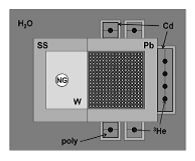
Figure
25. Schematic cross-sectional view of the DDA
instrument
The DDA method uses the difference in die-away (or decay) time
between epithermal (medium energy) and thermal (low energy)
neutrons to characterize the amount of fissile material in spent
nuclear fuel assemblies. DDA uses a neutron generator to
induce fissions in the spent fuel. He-3 tubes in polyethylene
moderator detect neutrons. A cadmium liner around the
polyethylene is used for some of He-3 tubes to absorb thermal
neutrons and make the Cd-lined He-3 positions sensitive to only
fast (high energy) and epi-thermal neutrons. Without
the presence of fissile material in the spent fuel, epithermal and
fast neutrons die-away very quickly while thermal neutrons die-away
more slowly. As the amount of fissile material and neutron
production from fission increases, the die-away time of epi-thermal
neutrons gets closer to that of the thermal neutron
population. The shift in the epi-thermal neutron population
die-away time is proportional to that amount of fissile material in
the fuel. Figure 25 shows a diagram of the DDA system.
Source: V. Henzl, M.T. Swinhoe, S.J. Tobin, H.O. Menlove,
Measurement of the Multiplication of a Spent Fuel Assembly with the
Differential Die-away Method Within the Scope of the Next
Generation Safeguards Initiative Spent Fuel
Project," Journal of Nuclear Materials
Management 40:3 (2012).